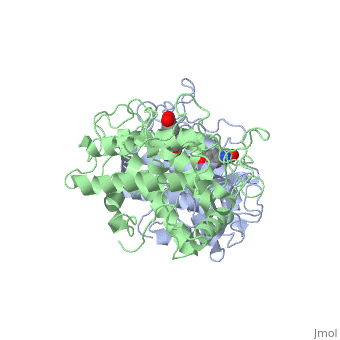Function
Tyrosinase or monophenol monooxygenase or polyphenol oxidase (Tyr) is a copper-containing enzyme which catalyzes the production of melanin and other pigments by oxidation of tyrosine. Tyr is involved in the hydroxylation of monophenol and the conversion of o-diphenol to o-quinone.
- β-Tyr (BTyr) or tyrosine phenol-lyase hydrolyzes tyrosine to phenol, pyruvate and NH3.
- Tyr 3 (Tyr3) or polyphenol oxidase catalyzes the hydroxylation of monophenols to diphenols.
See also Apple polyphenol oxidase.
Relevance
Tyr inhibitors are used in dermatological treatments and in cosmetics[1].
Disease
Mutation in Tyr leads to albinism. In melanoma patients, Tyr activity is uncontrolled resulting in increase in melanin production.
The mechanism of copper uptake by tyrosinase from Bacillus megaterium [2]
Tyrosinase belongs to the type-3 copper enzyme family, containing a di-nuclear Cu center, CuA and CuB. It is mainly responsible for melanin production in a wide range of organisms. Although Cu ions are essential for the activity of tyrosinase, the mechanism of Cu uptake is still unclear.
We have recently determined the from Bacillus megaterium (TyrBm) and revealed that this enzyme has tighter binding of CuA in comparison to CuB. Using a rational design approach and structure-function investigations, we identified four residues at the second shell of the active site, having an impact on Cu uptake. The (PDB 3nq0) is shown. are colored in green and are ligating only CuA which is shown as the sphere. are colored in orange and in this article were investigated by site directed mutagenesis. Looking at the crystal structure of WT TyrBm, we have found that a major role of the highly conserved Asn205 residue is to stabilize the orientation of the His204 imidazole ring in the binding site, thereby promoting the correct coordination of CuB. (PDB 4hd4) is shown. Residues His60 and Met61 colored in green and orange, respectively. Residue His60 is shown in two conformations, coordinating CuA in the active site or flipped out towards Met61.
Substitution of Asn205 to Ala or Asp residues resulted in significant reduction in copper uptake and enzymatic activity. In the crystal structure of variant N205D (PDB 4j6v), residue .
Furthermore, Phe197, Met61 and Met184, which are also located at the entrance to the active site, were found to play an important role in Cu uptake. Substitution of a bulky Phe197 to Ala, resulted in higher Cu uptake, while mutations at positions 61 and 184, had an opposite effect. (4j6t). Six His residues composing the active site are colored in green and are ligating CuA and CuB ions which are shown as spheres. Alanine residue at position 197 is colored in yellow. In addition, it was found that these residues are also important for enhancing the diphenolase activity of the enzyme. Therefore, we can suggest that a Cu ion entering the active site (CuA) first associates with the methionine residues followed by its transfer to His60 in its flipped out conformation. Following Cu binding, His60 alters its conformation and transfers CuA into the active site in a paddle-like motion. We propose that CuB passes only through Asp205 and Phe197. The proposed pathway clarifies the previously reported observations of TyrBm’s tighter binding of CuA in comparison to CuB.
3D Structures of tyrosinase
Tyrosinase 3D structures

